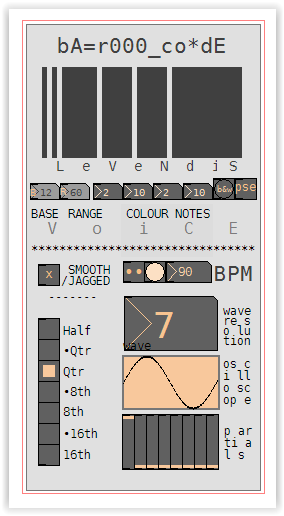Barcode is a random, additive synth. Permutations of the controls give rise to a broad range of timbres, generated by [sinesum(. i’m yet to hear it do the *beep* of a barcode scanner though.
CONTROLS
- [BASE] : Bottom note.
- [RANGE] : Distance between bottom and top notes.
- [COLOUR NOTES] : There are 4 of these. They alter the colour bands of the barcode graphic as well as determines which notes of the chromatic scale are played.
- [b&w] : Resets the colour bands and notes to duotone.
- [pse] : Pauses the barcode graphic. Consequently, arpeggiation is also halted. Timbre automation is uneffected.
- [SMOOTH/JAGGED] : Toggles between interpolated and steppy waveform transition.
- [• •] : Toggles between manual and automatic adjustment of [partials].
- [☼] : Visual metronome.
- [BPM] : Tempo. Pairs with [DIVISION] to mete out triggers on notes and barcode graphic.
- [DIVISION] : Faster/slower triggers.
- [waveresolution] : (2…12) A bit like a bit reducer ??
- [oscilloscope] : Displays a single cycle of the signal.
- [partials] : Amplitudes of the 8 partials of the sound.
EXTRA CREDIT
Cheetomoskeeto’s YouTube playlist
KNOWN ISSUES
- Setting [waveresolution] to a value >= 9 breaks [oscilloscope]’s refresh (animation freezes). It also adds some colour to the harmonics (distortion).
- The arpeggiation is a bit staid. Adjusting [BASE], [RANGE], [COLOUR NOTES], [BPM] and [DIVISION] helps break the monotony.
PERSONAL NOTE
i tend to use Barcode to generate samples. Primarily for slicing out single-cycle waveforms, for use elsewhere. Create and connect a [writesf~] to [catch~ voices] to do that too.
i wrote this patch in a time before i knew how to make localised objects. This means that having another patch open alongside Barcode may be problematic.


